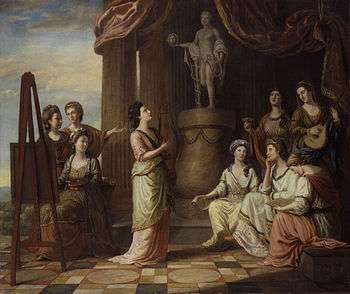Beatrix de Vesci
Beatrix de Vesci of Alnwick Castle, was an eleventh-century medieval noble lady of house de Vesci.[1]
Beatrix de Vesci | |
|---|---|
| Baroness of Alnwick Castle | |
 | |
| Born | Alnwick Castle, Northumberland |
| Died | c. 1125 Knaresborough, Yorkshire |
| Husband | Eustace Fitz John (1089 - 1157) |
| Father | Ivo de Vesci (c. 1045 – c. 1100) |
Life
Daughter and sole heir of Ivo de Vesci,[2] Builder and first Baron and his wife, Alda,[3][4] Beatrix de Vesci was one of the richest heiresses of her time.[5] She was the first wife of Eustace Fitz John, also known as Eustacius fitz John de Burgo, Constable of Chestershire and Knaresborough.[6]
According to Dugdale, Beatrix had two sons, William and Geoffrey.[7] However, it is most often said that she died during childbirth of her first and only son, William de Vesci.[8] William de Vesci took his mother’s surname and would become the ancestor of the de Vesci baronial house.[9][10] William served as Sheriff of Northumberland from 1157 to 1170,[11] and Sheriff of Lancashire from 1166 to 1170.[12]
Upon the death of Eustace Fitz John, his lands passed to his son William by consent of King Henry II.[13]
Beatrix de Vesci's grandson, Eustace de Vesci, was one of the Surety Barons of Magna Carta.[14]
References
- Geldard, Ed (2009). Northumberland strongholds. London: Frances Lincoln. p. 49. ISBN 9780711229853.
- Wurts, John (1945). Magna Carta. Philadelphia: Brookfield Publishing Company. pp. 72, 135.
- Hull, Lisa (2008). Understanding the Castle Ruins of England and Wales: How to Interpret the History and Meaning of Masonry and Earthworks. McFarland & Co. p. 195. ISBN 978-0-7864-3457-2.
- Burke, John (1837). A general and heraldic dictionary of the peerage and baronetage of the British empire. London: Henry Colburn. p. 352.
- Grainge, William (1871). The history and topography of Harrogate, and the forest of Knaresborough. London: J.R. Smith. p. 51.
- Browning, Charles Henry (1969). Magna charta barons and their descendants; with the story of the great charter of King John. Baltimore: Genealogical Pub. Co. p. 129.
- Cokayne, George Edward (1959). G.H. White; R.S. Lea (ed.). The Complete Peerage Vol. XII/2 (2nd ed.). London: The St. Catherine Press, Ltd. p. 276.
- Tate, George. 1866. The history of the Borough, Castle, and Barony of Alnwick. Alnwick: H.H. Blair. 56.
- Burke, John Bernard (1883). Genealogical History of the Dormant, Abeyant, Forfeited, and Extinct Peerages of the British Empire. London: Harrison. p. 555.
- Tout, T. F.; Dalton, Paul (2004). Eustace Fitz John: Justice and Baron. Oxford Dictionary of National Biography.
- Chalmers, George (1807). Caledonia: Or, an Account, Historical and Topographic, of North Britain; From the Most Ancient to the Present Times. Vol. I. London: T. Cadell, and W. Davies, Strand; and A. Constable Co., at Edinburgh. p. 532.
- "High Sheriff of Lancashire". Geni.com. Retrieved 16 October 2012.
- Dalton, Paul (1996). "Eustace Fitz John and the Politics of Anglo-Norman England: The Rise and Survival of a Twelfth-Century Royal Servant". Speculum. Speculum (Medieval Academy of America). 71 (2): 380. doi:10.2307/2865417. JSTOR 2865417.
- "Magna Carta Surety Barons". The Magna Carta. Runnymede Borough Council. Archived from the original on 30 August 2012. Retrieved 16 October 2012.
